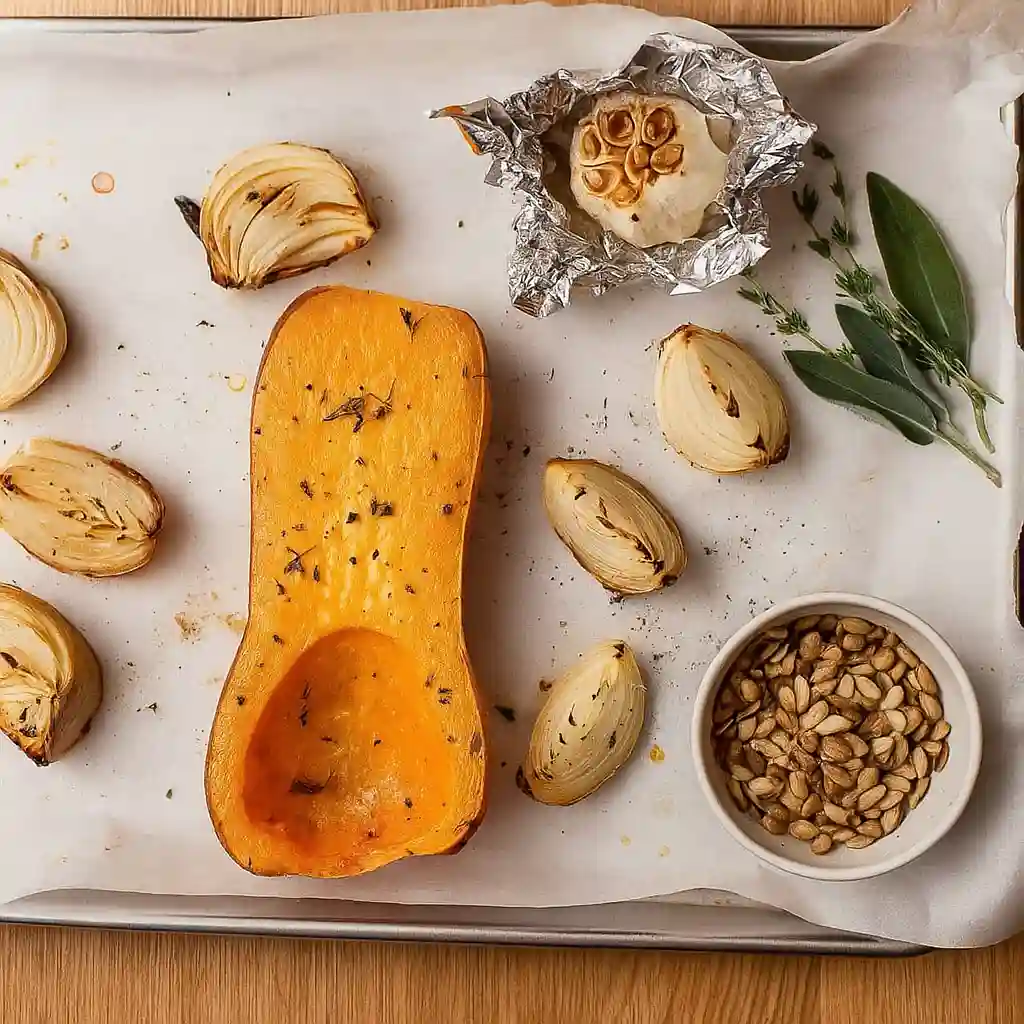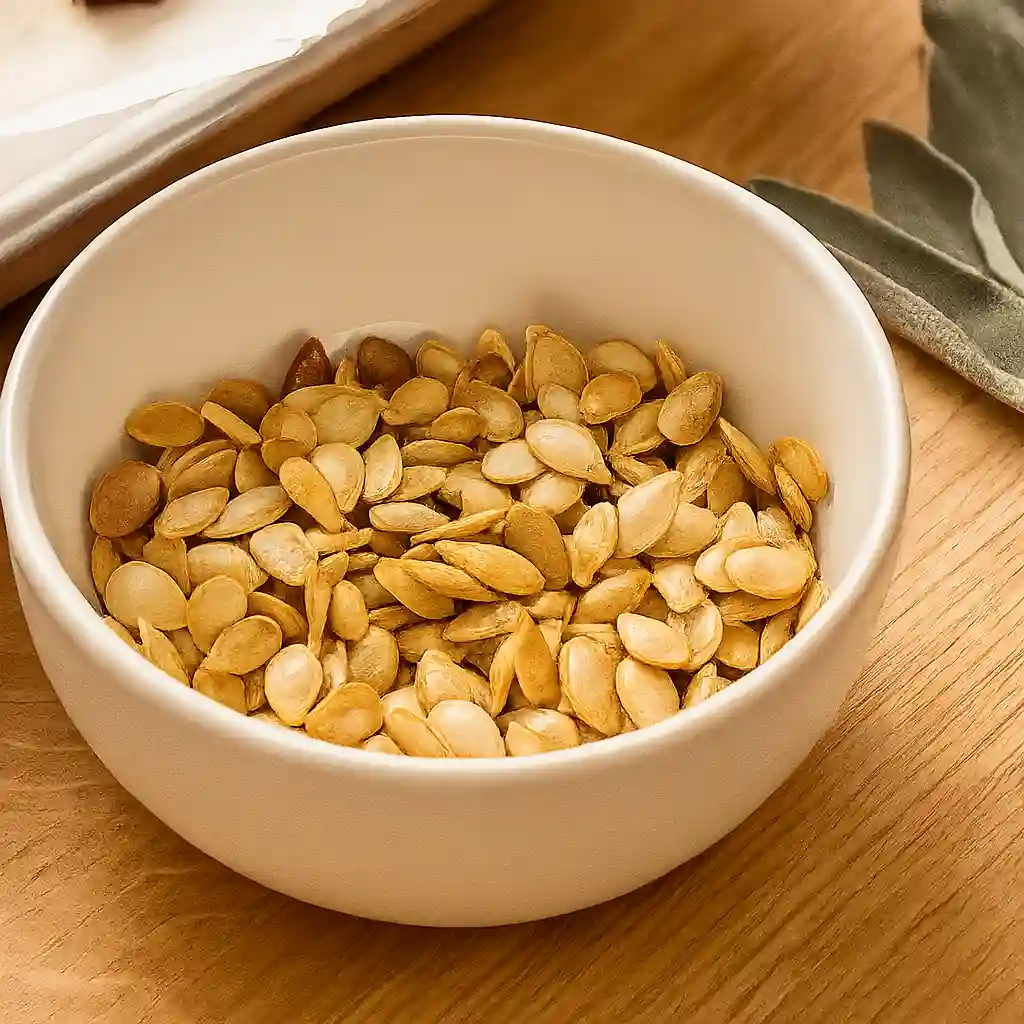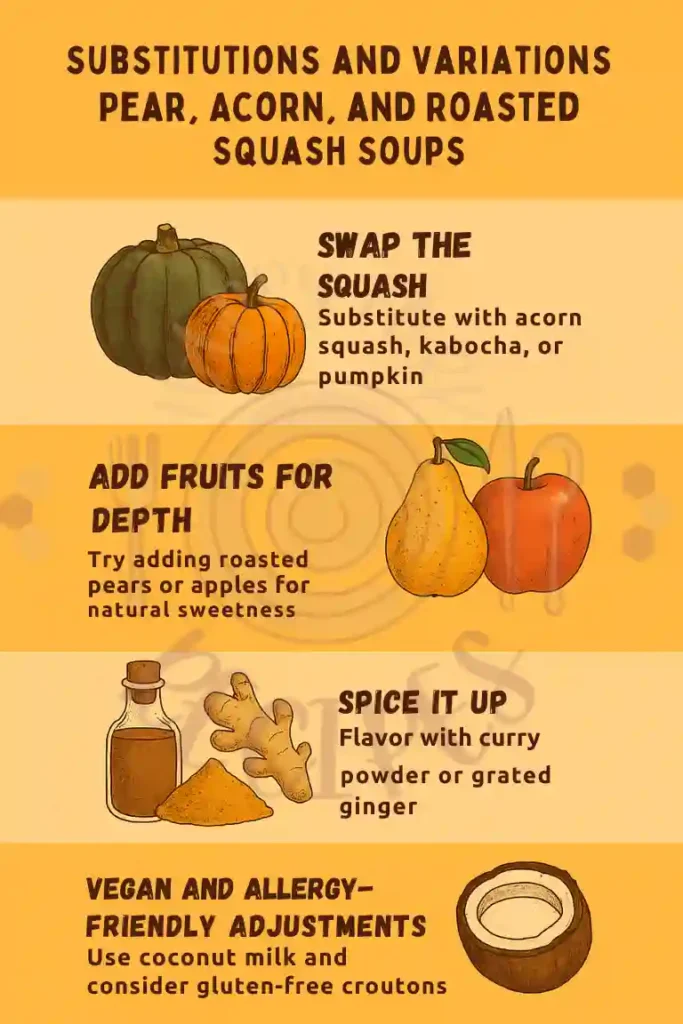Why This Is the Best Fall Soup Recipe for Comfort & Warmth
Roasted butternut squash soup is what fall tastes like. It’s cozy, creamy, and filled with rich, earthy flavor that comes alive when the squash is roasted until golden and soft. This isn’t just soup. It’s comfort in a bowl.
What makes this version special is how simple it is to prepare while still feeling indulgent. Roasting adds depth, and blending it all into a smooth, velvety texture makes every spoonful satisfying. Whether you use cream or keep it vegan, the result is warm, filling, and perfect for chilly nights.
If you’re craving healthy soup recipes that actually taste amazing, this one delivers. It’s also flexible. You’ll find tips for adding pears, using different squash, and storing it for later. Whether you’re cooking for yourself or feeding a group, this is the fall soup that keeps getting made again and again.
Table of Contents
Ingredients for Butternut Squash Soup (With Vegan and Pear Variations)
The beauty of roasted butternut squash soup is that it starts with just a few fresh ingredients. Each one adds depth and comfort without overcomplicating the process. Here’s everything you’ll need to get started, including simple swaps for vegan options and subtle flavor twists like pear.
Main Ingredients:
- Butternut Squash (3 to 4 pounds): Choose one that feels heavy and has smooth, blemish-free skin.
- Onion: A medium yellow onion works well, but white or sweet onions are also fine.
- Garlic: One whole head, roasted to bring out a mellow, caramelized flavor.
- Olive Oil: Used for roasting and enhancing flavor.
- Fresh Herbs: Sage and thyme are classic fall flavors that pair beautifully with squash.
- Salt and Pepper: Simple seasoning to balance sweetness and bring everything together.
- Vegetable Broth: Keeps the recipe vegetarian. You can use chicken broth or even water if needed.
- Heavy Cream: Adds richness and silkiness. For dairy-free options, try cashew cream or full-fat coconut milk.
- Croutons and Roasted Seeds: Optional toppings for crunch and texture.
Optional Additions:
- Pears: Roasted pear adds a sweet contrast. Use firm varieties like Bosc or Anjou.
- Applesauce: Just half a cup can give the soup a hint of sweetness without overpowering it.
- Carrots: Roast them with the squash for added depth and natural sugar.
Vegan-Friendly Swaps:
- Replace heavy cream with coconut milk or blended cashew cream.
- Use vegetable broth and skip the croutons unless they are dairy-free.
This ingredient list offers a solid foundation with plenty of room for creativity. Whether you’re aiming for a traditional roasted butternut squash soup or experimenting with a pear-enhanced version, these ingredients will support both flavor and flexibility.
How to Make Roasted Butternut Squash Soup (Step-by-Step Guide)
Making roasted butternut squash soup at home is easier than it looks. With a little prep and one baking sheet, you can create a rich, flavorful soup that tastes like it simmered all day.
Step 1: Roast the Vegetables
Start by preheating your oven to 425°F. Line a baking sheet with parchment paper for easy cleanup.
Cut the butternut squash in half lengthwise and scoop out the seeds. Set the seeds aside in a colander if you plan to roast them later. Peel the onion and cut it into large chunks. Slice off the top of the garlic head, drizzle it with olive oil, sprinkle with a pinch of salt, and wrap it tightly in foil.
Place the squash, onions, and wrapped garlic on the baking sheet. Drizzle with olive oil and season with salt, black pepper, chopped sage, and thyme leaves. Roast for about 45 minutes or until the squash is fork-tender and the onion has softened.
Step 2: Roast the Seeds (Optional)
While the vegetables are roasting, rinse the seeds under cold water to remove pulp. Dry them with a clean towel, then toss with olive oil and a bit of salt. After the vegetables are done, reduce the oven temperature to 350°F. Spread the seeds on a clean baking sheet and roast for 15 to 20 minutes, stirring halfway through.


Step 3: Blend the Soup
Once the roasted vegetables are cool enough to handle, scoop the squash flesh into a large pot. Squeeze the roasted garlic cloves from their skins and add them, along with the onions and vegetable broth.

Use an immersion blender to puree the soup until smooth. If you do not have an immersion blender, a regular blender will work. Just blend in batches and transfer the soup back to the pot.
Step 4: Adjust and Serve
Warm the soup gently over medium heat. Stir in the cream or your dairy-free option. If the soup is too thick, add a bit more broth. If it feels too thin, let it simmer uncovered until it thickens.

Taste and adjust seasoning if needed. Serve warm, topped with roasted seeds and croutons for texture.
Flavor Tips and Fall Soup Upgrades (From Butter Squash to Roasted Pear)
Roasted butternut squash soup is already full of character, but a few small tweaks can elevate it from simple to exceptional. These tips will help you bring out the best in every batch, whether you’re making it for a quiet dinner or a cozy gathering.
Boost the Flavor with Spices
While sage and thyme provide a classic fall profile, consider adding a pinch of ground nutmeg or cinnamon for warmth. If you like a subtle kick, a dash of cayenne or smoked paprika adds a lovely contrast to the natural sweetness of the squash.
Freshly ground black pepper can also enhance the earthy tones. Just remember to add spices gradually and taste as you go.
Use Pear or Apple for a Sweet Twist
Roasting a peeled, cored pear or apple alongside the squash can introduce a layer of gentle sweetness. This works particularly well if you are serving the soup as a starter for a holiday meal. Pear pairs beautifully with thyme and sage, while apple lends itself to cinnamon or rosemary.
If fresh fruit is not available, try adding half a cup of unsweetened applesauce during blending.
Texture Adjustments
For extra creaminess, blend in a spoonful of cashew cream or coconut milk after pureeing. If your soup ends up thicker than you’d like, thin it with warm broth. If it feels too light, let it simmer a little longer with the lid off.
A splash of lemon juice or apple cider vinegar at the end can also brighten the flavor without making it tangy.
Common Flavor Variations to Try:
- Roasted Butternut Squash and Pear Soup
- Butternut Squash Soup with Curry and Coconut Milk
- Butter Squash Soup with Cinnamon and Nutmeg
- Roasted Squash Soup with Ginger and Apple
These additions let you tailor the soup to your mood or your pantry, making it endlessly adaptable.
Substitutions and Variations: Pear, Acorn, and Roasted Squash Soups
One of the best things about butternut squash soup is how easily it adapts to different flavors and ingredients. Whether you are cooking with what’s in season or adjusting for dietary needs, there are plenty of ways to keep the base recipe fresh and exciting.
Swap the Squash
If you do not have butternut squash, acorn squash makes a great substitute. It has a slightly milder flavor but roasts beautifully and blends into a smooth texture. You can also experiment with kabocha squash or a mix of different winter squash varieties for a deeper flavor.
Pumpkin works too, especially if you’re going for a more traditional fall soup recipe. Just make sure it is a sugar pumpkin, not the kind used for carving.
Add Fruits for Depth
Roasted pear adds a natural sweetness that pairs well with herbs like sage and thyme. For a lighter, brighter soup, apples work just as well. These fruits can be roasted alongside the squash or blended in raw, depending on the flavor you want.
Combining butternut squash and pear is a favorite twist that brings a soft, floral note to the soup. It is especially good for holiday meals or when you want something a bit more refined.

Spice It Up
For a bold change, stir in curry powder or a bit of grated ginger. These spices add warmth and complexity, making the soup feel more global. A spoonful of chili oil or a sprinkle of crushed red pepper can also turn up the heat without overpowering the sweetness of the squash.
Vegan and Allergy-Friendly Adjustments
Use coconut milk or cashew cream instead of heavy cream for a dairy-free version. Be sure your broth is vegetable-based, and swap out the croutons for a gluten-free or grain-free alternative if needed.
These easy swaps open the door to endless versions of roasted squash soup, all equally cozy and satisfying.
Best Ways to Serve Butternut Soup (Sandwich Buffet, Stews, and More)
A warm bowl of roasted butternut squash soup is comforting on its own, but it becomes even more satisfying when paired thoughtfully. Whether you’re planning a quiet lunch or a weekend gathering, here are a few ways to serve it that bring extra flavor and variety to the table.
Pair It with a Sandwich Buffet
Butternut squash soup pairs beautifully with grilled cheese or panini sandwiches. Set up a sandwich buffet with options like sourdough, focaccia, cheddar, mozzarella, and pesto spreads. This setup works well for family dinners or casual hosting. The richness of the soup balances perfectly with crispy, toasted bread.
You can also include lighter options like turkey and cranberry sliders or apple and brie on multigrain rolls. The contrast between the sweet, creamy soup and savory sandwich fillings is a guaranteed crowd-pleaser.
Serve as a Starter or Side
This soup fits easily into a larger fall meal. Serve smaller portions alongside roasted meats, grain bowls, or seasonal stews. It brings a pop of color and a warm, cozy note that complements dishes made with sage, rosemary, or root vegetables.
When served in small cups or bowls, this soup also makes an elegant starter for holiday dinners or brunches.
Garnishes That Add Texture
Top your soup with homemade croutons, roasted squash seeds, or a drizzle of olive oil. A swirl of cream or a sprinkle of chopped herbs gives it a fresh finish. These small touches elevate the presentation and create a mix of textures in each bite.
Butternut squash soup is versatile and easy to dress up or keep simple. With just a few extras, it can become the highlight of any fall menu.
FAQs About Butternut Squash Soup Recipes
Can I make this soup ahead of time?
Yes, roasted butternut squash soup is a great make-ahead meal. After blending and seasoning, let it cool, then store it in an airtight container in the refrigerator. It will keep well for up to four days. Reheat it gently on the stovetop, stirring occasionally until hot.
What if I do not have an immersion blender?
A regular blender works just fine. Blend the soup in small batches to avoid spills. Be sure to let the vegetables cool slightly before blending to prevent pressure build-up. Once smooth, return the soup to the pot and continue with the recipe.
Can I freeze butternut squash soup?
Absolutely. Let the soup cool completely before transferring it to a freezer-safe container. Leave some space at the top since the liquid will expand. It will stay fresh in the freezer for up to three months. Thaw overnight in the refrigerator and reheat on the stove.
How do I make this recipe vegan?
To keep the soup vegan, use vegetable broth and replace heavy cream with coconut milk or homemade cashew cream. Be sure any croutons or toppings you add are also plant-based.
What are the best garnishes?
Some of the best garnishes include roasted squash seeds, a drizzle of olive oil, crispy croutons, or a dollop of dairy-free cream. You can also add fresh herbs like parsley or chives for a bright finish.
These tips should help you adapt, store, and enjoy your soup with ease no matter the occasion.
Butternut Squash Soup Nutrition Info
Understanding what goes into your bowl can make enjoying it even more satisfying. Roasted butternut squash soup is not only comforting but also full of nutrients that support a balanced diet. Below is the estimated nutritional breakdown per serving, based on a recipe that includes cream and croutons.
Estimated Nutrition Per Serving:
- Calories: 360
- Total Fat: 15g
- Saturated Fat: 6g
- Cholesterol: 25mg
- Sodium: 760mg
- Carbohydrates: 59g
- Fiber: 7g
- Sugars: 12g
- Protein: 8g
- Vitamin A: Over 100 percent of daily recommended intake
- Vitamin C: Around 40 percent of daily recommended intake
- Calcium and Iron: Present in moderate amounts
Lighter Variations
For a lighter version, skip the cream or use a dairy-free alternative like coconut milk. This change can lower the fat and calorie content while keeping the soup smooth and rich. Leaving out the croutons or using gluten-free versions can also reduce carbs if needed.
This soup provides a hearty and nutritious meal with plenty of room to adjust based on your preferences.

Final Thoughts on the Perfect Fall Squash Soup
Roasted butternut squash soup offers more than just a warm meal. It brings a sense of calm to a chilly evening, a welcome break in a busy week, or a thoughtful start to a holiday dinner. With its creamy texture and naturally sweet depth of flavor, this soup has a way of sticking in your memory long after the bowl is empty.
What makes this recipe special is how adaptable it is. Whether you keep it classic, stir in roasted pear, or take it in a spiced direction with curry or ginger, it always delivers comfort. It is also simple enough for weeknights but elegant enough for gatherings.
If you have been searching for a fall soup recipe that is easy to love and easy to repeat, this one belongs in your rotation. Try it once, make it your own, and don’t be surprised if it becomes your go-to comfort meal for the season.

Roasted Butternut Squash Soup
Equipment
- Baking Sheet
- Parchment paper
- Knife
- Foil
- Stockpot
- Immersion Blender
Ingredients
Soup Ingredients
- 1 3-4 lb butternut squash
- 1 medium yellow onion
- 1 head garlic
- 2 tablespoons olive oil
- 1 teaspoon sea salt
- 0.5 teaspoon cracked black pepper
- 1 teaspoon fresh chopped sage
- 1 teaspoon fresh thyme leaves
- 3 cups vegetable broth or chicken broth
- 0.5 cup heavy cream or coconut milk or cashew cream
- croutons optional, for topping
- roasted squash seeds optional, for garnish
Instructions
- Preheat the oven to 425°F and line a baking sheet with parchment paper.
- Cut the squash in half lengthwise and scoop out the seeds. Save seeds for roasting if desired.
- Peel and quarter the onion. Cut the top off the garlic head, drizzle with olive oil, sprinkle with salt, and wrap in foil.
- Place squash, onion, and garlic on the baking sheet. Drizzle vegetables with olive oil and season with salt, pepper, sage, and thyme.
- Roast for 45 minutes or until the squash is fork-tender. Let vegetables cool slightly.
- Scoop the squash flesh into a stockpot. Squeeze roasted garlic from its skin and add with the onion and broth.
- Use an immersion blender to puree until smooth. Heat soup gently and stir in cream or substitute. Adjust seasoning to taste.
- Serve hot, topped with croutons and roasted seeds if desired.
Notes
- Calories: 360
- Total Fat: 15g
- Saturated Fat: 6g
- Cholesterol: 25mg
- Sodium: 760mg
- Carbohydrates: 59g
- Fiber: 7g
- Sugars: 12g
- Protein: 8g
- Vitamin A: Over 100 percent of daily recommended intake
- Vitamin C: Around 40 percent of daily recommended intake
- Calcium and Iron: Present in moderate amounts
For more creative cooking & baking inspiration ideas, explore the Pinterest or connect with us on Facebook.



